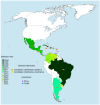Huanglongbing as a Persistent Threat to Citriculture in Latin America
- PMID: 40282200
- PMCID: PMC12025139
- DOI: 10.3390/biology14040335
Huanglongbing as a Persistent Threat to Citriculture in Latin America
Abstract
Citrus commercial species are the most important fruit crops in the world; however, their cultivation is seriously threatened by the fast dispersion of emerging diseases, including Huanglongbing (HLB) citrus greening. HLB disease is vectored by psyllid vectors and associated with phloem-limited α-proteobacteria belonging to the Candidatus Liberibacter genus. Climatic change and trade globalization have led to the rapid spread of HLB from its origin center in Southeast Asia, causing a great economic impact in the main production areas, including East Asia (China), the Mediterranean basin, North America (the United States), and Latin America (Brazil and Mexico). Despite important advances to understand the HLB epidemiology, Candidatus Liberibacter genetics, psyllid vector control, the molecular citrus-Candidatus Liberibacter interaction, and the development of integral disease management strategies, the study areas have been mostly restricted to high-tech-producing countries. Thus, in this review, we provide an overview of the epidemiology, distribution, genetic diversity, management aspects, and omics analysis of HLB in Latin America, where this information to date is limited.
Keywords: Candidatus Liberibacter genus; HLB epidemiology; HLB management methods; Huanglongbing (HLB); Latin America.
Conflict of interest statement
The authors declare no conflicts of interest. The funders had no role in the design of this study; in the collection, analyses, or interpretation of the data; in the writing of the manuscript; or in the decision to publish the results.
Figures




Similar articles
-
'Candidatus Liberibacter americanus', associated with citrus huanglongbing (greening disease) in São Paulo State, Brazil.Int J Syst Evol Microbiol. 2005 Sep;55(Pt 5):1857-1862. doi: 10.1099/ijs.0.63677-0. Int J Syst Evol Microbiol. 2005. PMID: 16166678
-
Progress and Obstacles in Culturing 'Candidatus Liberibacter asiaticus', the Bacterium Associated with Huanglongbing.Phytopathology. 2019 Jul;109(7):1092-1101. doi: 10.1094/PHYTO-02-19-0051-RVW. Epub 2019 Jun 3. Phytopathology. 2019. PMID: 30998129 Review.
-
Study on the citrus greening disease: Current challenges and novel therapies.Microb Pathog. 2024 Jul;192:106688. doi: 10.1016/j.micpath.2024.106688. Epub 2024 May 14. Microb Pathog. 2024. PMID: 38750772 Review.
-
First Report of a Huanglongbing-Like Disease of Citrus in Sao Paulo State, Brazil and Association of a New Liberibacter Species, "Candidatus Liberibacter americanus", with the Disease.Plant Dis. 2005 Jan;89(1):107. doi: 10.1094/PD-89-0107A. Plant Dis. 2005. PMID: 30795297
-
Etiology of three recent diseases of citrus in São Paulo State: sudden death, variegated chlorosis and huanglongbing.IUBMB Life. 2007 Apr-May;59(4-5):346-54. doi: 10.1080/15216540701299326. IUBMB Life. 2007. PMID: 17505974 Review.
References
-
- Food and Agriculture Organization of the United Nations FAOSTAT Statistical Database. 2023. [(accessed on 5 March 2025)]. Available online: https://www.fao.org/faostat/en/#data/QCL/visualize.
-
- Bové J.M. Huanglongbing: A Destructive, Newly-Emerging, Century-Old Disease of Citrus. J. Plant Pathol. 2006;88:7–37.
-
- USDA FAS World Agricultural Production. [(accessed on 5 March 2025)]; Available online: https://fas.usda.gov/data/production.
-
- Etxeberria E., Gonzalez P., Achor D., Albrigo G. Anatomical Distribution of Abnormally High Levels of Starch in HLB Affected Valencia Orange Trees. Physiol. Mol. Plant Pathol. 2009;74:76–83. doi: 10.1016/j.pmpp.2009.09.004. - DOI
-
- Gottwald T.R. Current Epidemiological Understanding of Citrus Huanglongbing. Annu. Rev. Phytopathol. 2010;48:119–139. - PubMed
Publication types
Grants and funding
LinkOut - more resources
Full Text Sources

